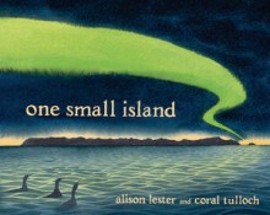One small island by Alison Lester and Coral Tulloch

Penguin, 2011. ISBN 978 0 670 072363.
(Ages 8+) Highly recommended. Picture book. Environment. A
stunning portrayal of the Southern Aurora greets the reader as they
pick up this inviting book, containing information about Macquarie
Island while telling the story of the place and how it has survived
the
ravages of our invasion.
The endpapers welcome the readers with a beautiful map alongside the
factual tale of the island's history from tis geological past to the
present day.
Opening and ending with a stunning vista of this isolated island
from
the perspective of the albatross, the book implores us to help save
this precious place, and so all such places. Each double page spread
separated by these endpapers alternates between pages seemingly from
a
note book with snippets of hand written information gathered in the
field, with drawings and sketches of things seen, and paintings that
fill the double page, with a single clear message. About half way
through the book, for example, is a double page of information about
the penguin oil industry taken from accounts at the time, with
drawings
of the places this was carried out, pictures of the penguins and of
the
ships involved in the trade. A gruesome read. Following that is a
double page of penguins resting on their rocky shore, albatross in
the
deep grey sky, and seals beside them on the beach, with the
information
that the island became a wildlife sanctuary in 1933. The comparison
between the two double pages will entreat readers to stop and give
thought to the scale of that announcement and what it meant for the
island. Other pages are similarly comparable. One about the arrival
of
people on its shores, and the next the destruction caused by the
cats
brought with them. Another showing the range of new wonders to be
found
on the island, the next the settlement by the sealers, with blood
along
the beach.
Each invites the reader to think further, to give thought to the
fate
of places such as this and hence to the wider world under threat
from
our encroachment. The last few pages tell the reader of some of the
projects underway limiting the destruction caused, and the results
of
this, while the end comes back to the albatross in the sky looking
down
on an island somewhat different from the one at the start. A
timeline,
glossary and another map with climate statistics rounds off a
spectacular book, a homage to Macquarie Island that will be sought
after by teachers and students to use as part of their discussions
about their environment, sustainability, conservation and
rehabilitation.
Fran Knight